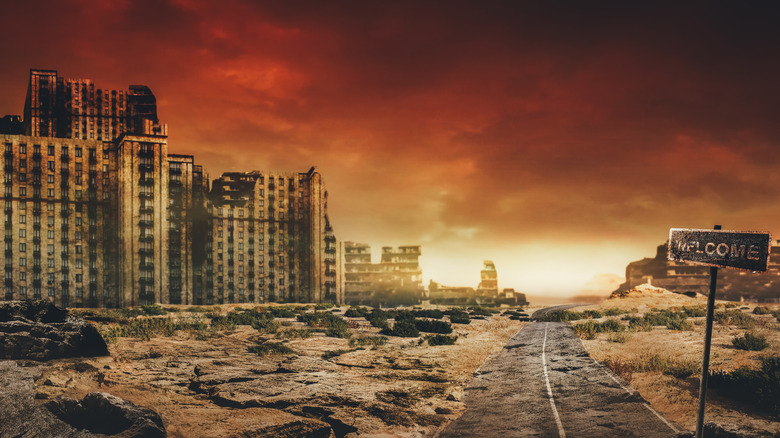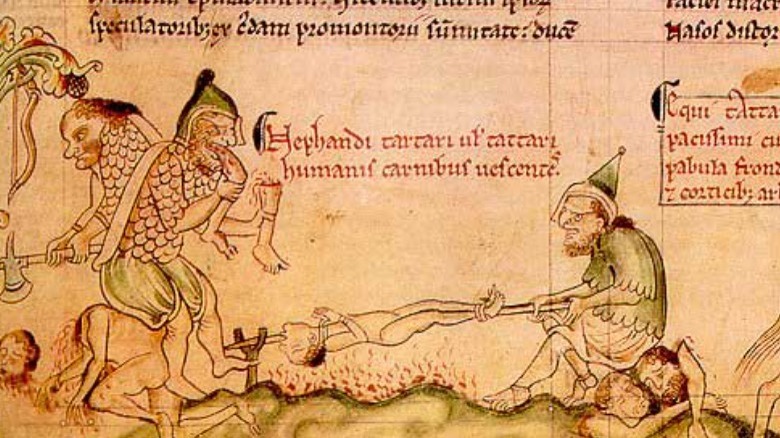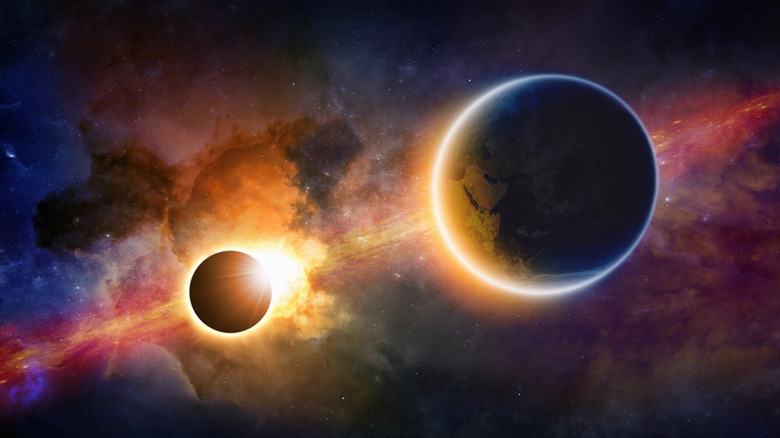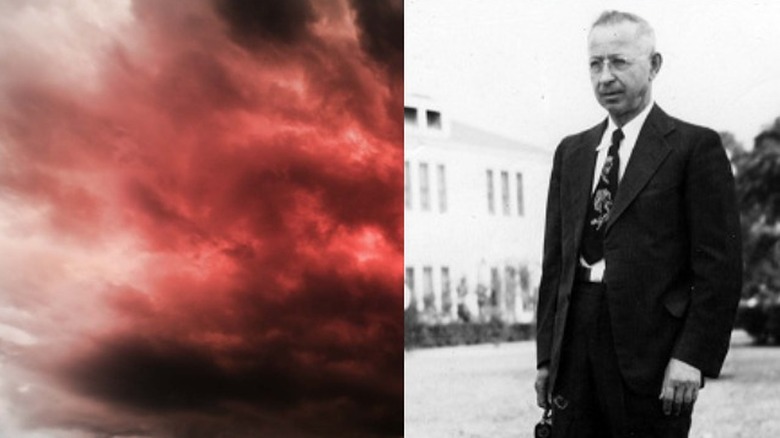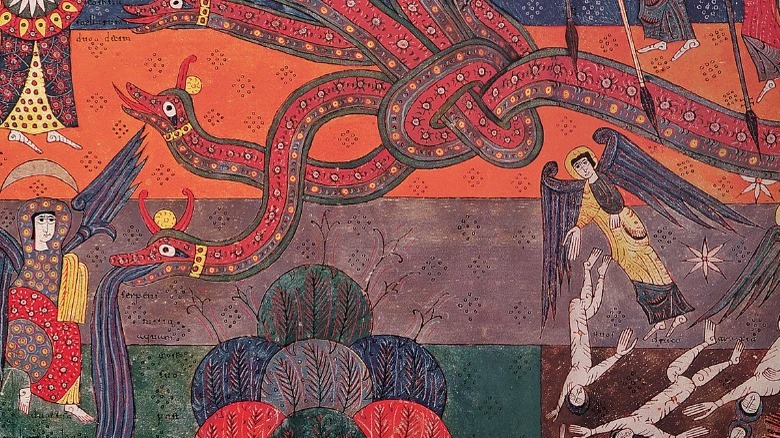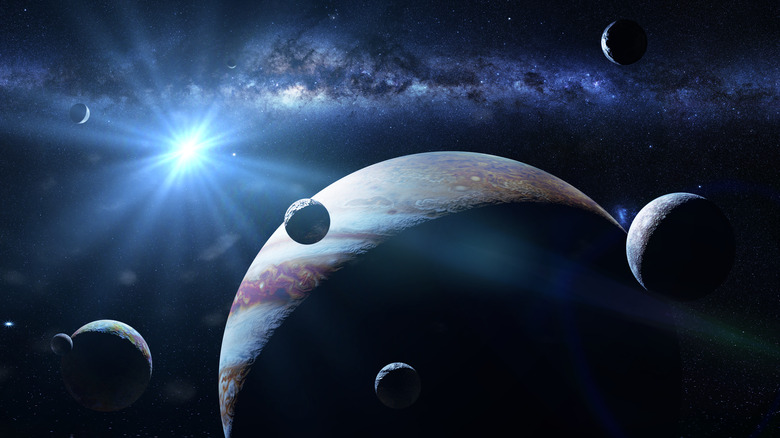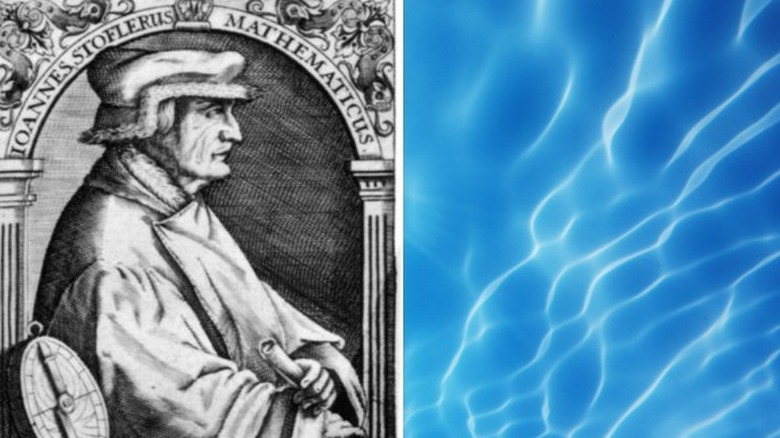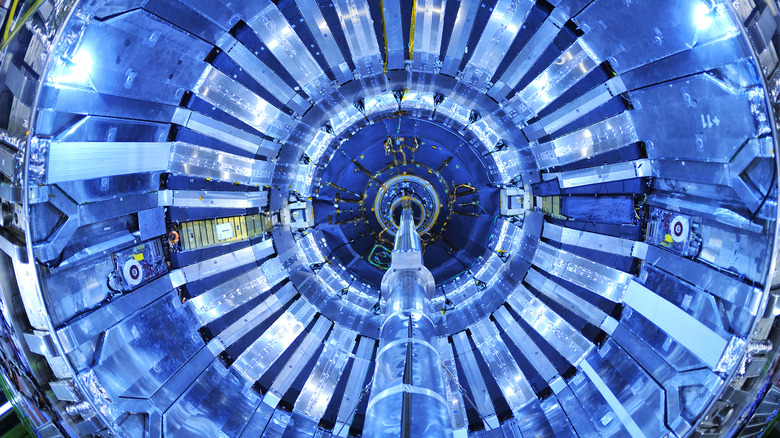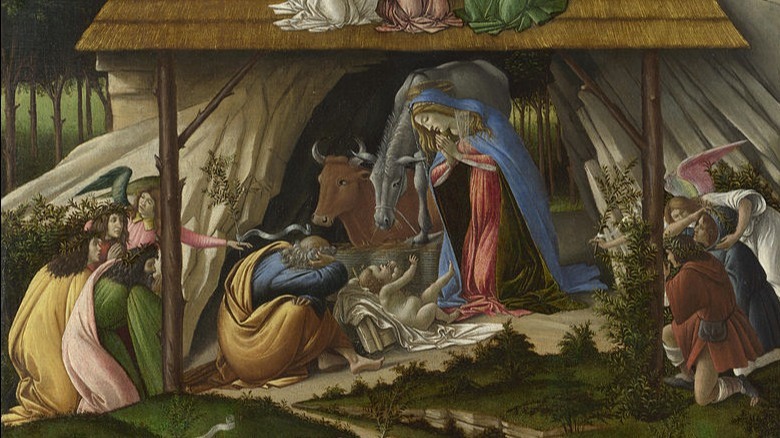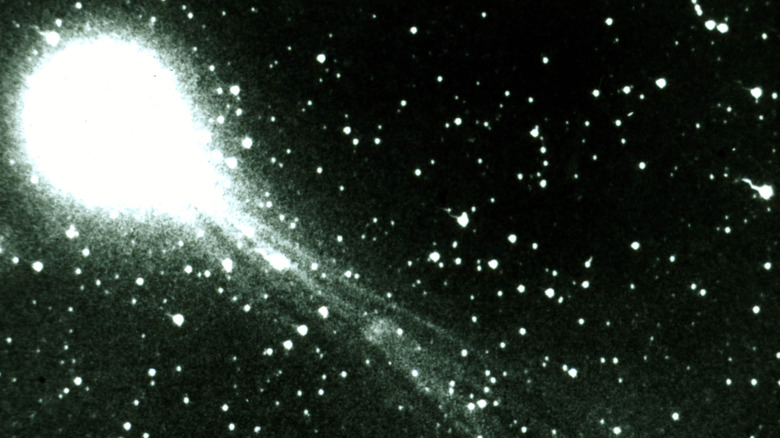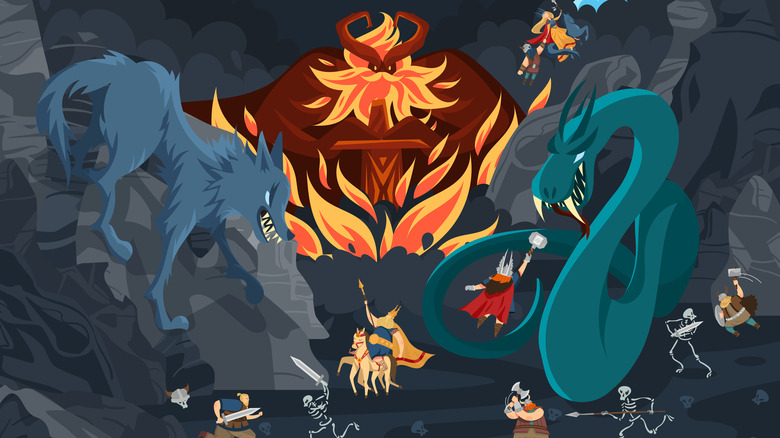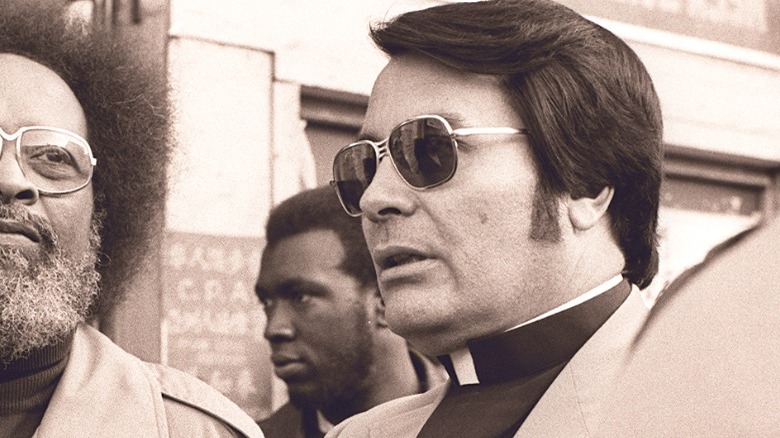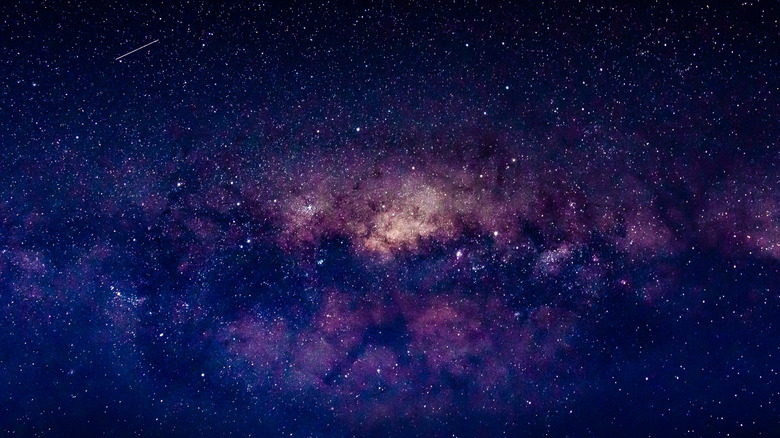The Scariest Apocalypses Predicted Throughout History
It says a lot about our modern world that the end of it doesn't look too terrible. Whether it comes with a side of zombies or after a nuclear winter, there's a prevailing sense that it just might be better than a world filled with red tape and middle management.
Apocalyptic predictions are usually taken with a grain of salt ... with one major and fairly recent exception. That, says Forbes, was Y2K. The idea was that computers weren't going to be able to deal with a date code that had a year ending in "00," and no one really knew what was going to happen. The world was already pretty dependent on computers, though, with experts therefore expecting everything from the shutdown of hospitals, power plants, and other critical infrastructure to the global failure of the banking system. In the end, of course, nothing really happened, but it was such a realistic-sounding prospect that it seemed the world might realize how dangerous a complete dependence on computers was. (It did not.)
Fears about the end of the world tend to target what people feel the most, and there have been plenty of times that prophets have spoken about the end of the world. Oftentimes, it's more terrifying than reprimands for forgetting a cover sheet on those darn reports.
Matthew Paris and the Chronica Majora
When apocalyptical warnings come from a respected authority, people tend to pay attention. Matthew Paris was one of the authors of the "Chronica Majora," a gargantuan tome that documented history as it happened. It was started in 1201 — Paris took over in 1235 — and as far as he was concerned, he was living in the end times (via History Today).
Paris had started to see a pattern that he believed was leading up to the apocalypse. That, he said, was going to happen in December of 1250, and he painted a pretty dark picture of what was happening (as outlined in "Tales of Wonder in the 'Chronica Maiora' of Matthew Paris").
In addition to abnormal weather events like floods, famines, and earthquakes, Paris also recorded a series of strange things spotted in the night sky: He wrote of stars falling from heaven, a dragon that was snaking its way toward earth, and a strange incident where "mock suns" appeared around the one sun that was supposed to be there. He described floodwaters that filled entire valleys, rocks that fell from mountains and wiped out entire villages, and a wind that turned yellow and infected with disease. His account of what he believed was the unfolding of the apocalypse was relentless: Famine led to the death of thousands, sea monsters were spotted in the Thames, and rivers of fire began to chase and consume those that fled ahead of it.
The Nibiru/Planet X collision
There are a lot of apocalypse scenarios that aren't too bad. Zombies, for instance ... they can't be too hard to survive, right? There's one that gives everyone a survival chance of precisely zero, though: The terrifying prophecy that the earth is on a collision course with another planet, and there's nothing anyone can do about it.
According to Space, the idea is rooted in a 1976 book called "The Twelfth Planet." Supposedly based on ancient texts, it claimed the planet Nibiru showed up every 3,600 years, and was slated to make a reappearance in 2003. When that didn't happen, it was rescheduled to 2012, or about the same time the Mayan calendar (supposedly) also predicted the end of the world.
When no rogue mystery planet destroyed the earth in a fiery collision in 2012, the zeitgeist that is conspiracy theories on the internet reset the date for 2017. According to National Geographic, when the April date came and went fairly peacefully, it was rescheduled for September, October, and finally November. None of those panned out, of course, but that's no reason to get a good conspiracy theory down: It was simply adjusted a bit to specify that it just sort of passed by during that time, and kick-started some weather and natural phenomenon that really were going to end the world.
Victor Houteff's teachings
After the infamous events in Waco, Texas, David Koresh is the most famous name associated with the Branch Davidians. However, they were around in another form long before Koresh — and their teachings were always terrifying.
According to Sarah Harvey's "David Koresh and the Branch Davidians," (via the Critical Dictionary of Apocalyptic and Millenarian Movements), the movement was sort of begun by a man named Victor Houteff. Houteff was a Seventh-Day Adventist who didn't believe their teachings about the end of the world, so he decided to start his own thing. According to him, the followers of his Shepherd's Rod movement would eventually number 144,000, and be the only ones to survive the end of the world. He started gathering his followers and calling them to a compound in Waco in 1934, based on prophecies that the 1260 days of Revelation were going to start on November 9, 1955. In an unnervingly detailed illustration, Houteff posited that the world was going to be visited by seven plagues (via Cabinet Magazine), but in the end, he didn't see it: He died in 1955.
The movement was taken over by his wife, Florence, who claimed that Victor would be resurrected at the end of those 1260 days, when a heavenly kingdom on Earth would be established, which would be based in Palestine. When that didn't happen, either, the Encyclopedia of Seventh-Day Adventists says that the group splintered — one of those groups included the Branch Davidians that Koresh would later lead.
European apocalypse manuscripts: Vomit floods
According to the British Library, apocalypse manuscripts were the best-sellers of the medieval world. Surviving examples suggest they were often ornately illustrated and written in French, which means they weren't just meant for the clergy. They were meant to be a little more accessible, and to be fair, medieval life was hard and everyone needed something to look forward to. The contents of many aren't just fire-and-brimstone; they believed the end times were going to come on the back — and in the stomachs — of some wild creatures.
The 11th-century Silos Apocalypse (pictured), for example, contains an illustration of a seven-headed dragon that's vomiting out a flood of water and drowning those who weren't carried up to Heaven. Terrible creatures vomiting up floods is something of a motif that occurs in manuscripts from other countries, too. Sometimes the creature is dragon-like, sometimes it's got multiple heads, sometimes it's almost griffon-like. They all spew forth floods, though, unconcerned for the people illustrated alongside them.
Monsters also vomit up floods of frogs. Better or worse? Hard to tell. Frogs, says the British Library, were meant to signify "unclean spirits," so maybe it is worse than water. There's also another frog-related warning: Some of the prophets and preachers also have frogs coming out of their mouths, signifying that when the end is nigh, it'll be hard to know who to trust.
The Jupiter Effect
While it might be tempting to laugh at our ancient ancestors for believing some of the wilder prophecies about the impending apocalypse, it's worth remembering that recent history has its fair share of these too. Take "The Jupiter Effect." This was a book that claimed the world was going to be destroyed by cataclysmic natural disasters when the planets all aligned on the same side of the sun, on March 10, 1982.
The problem, says Mental Floss, was that the book was presented by two writers who had some clout: John Gribbin was an astrophysicist, and Stephen Plagemann was an astronomer. So far, so good. And while most of the scientific community got a good laugh out of the whole thing, others didn't — because it seemed perfectly logical that the alignment might interfere with gravitational forces acting on the planets, and throw all kinds of natural processes out of whack. United Press International says that in some areas, the idea was taken incredibly seriously, with other portents of widespread disease outbreaks spreading on top of the natural disasters.
Nothing, of course, happened, and the book's authors even backed off on their position before the prophesied day. Still, there's a footnote to this: In 2022, researchers from Leiden University confirmed that the interior of Jupiter contained what LiveScience described as "remains of cannibalized baby planets," so maybe it's not so innocent after all.
The Great Flood of 1524
In 1524, the world was thrown into chaos around a prophecy that said a great flood was going to come and hit the reset button, Noah's ark-style. According to the James Randi Educational Foundation, this wasn't just a few people carrying sandwich boards saying, "The end is nigh." It was taken so seriously that around 20,000 people fled the sea-level-ish city of London, boat-builders became rich, and many, many people became incredibly poor when they sold their land and homes for a fraction of what they were worth — particularly waterfront properties.
On February 24 of that year, a German noble made a show of dragging the last of his supplies on board his three-story ark. He was heckled for a bit ... until it started to rain, kicking off a mass panic that led to him being stoned to death. And yes, the rain stopped.
Why was this particular prophecy so terrifying? Because it came from a well-respected, wildly learned person. The Oxford University Press says that in addition to being a maker of astronomical instruments, Johannes Stoffler was a professor, the chair of mathematics at the University of Tubingen, had published works that recorded the position of celestial bodies over decades, and he'd noticed that on February 24, 1542, the six known planets would align while they were all inside the constellation of Pisces. Clearly, it was a sign, and terror ruined countless lives. After the world didn't end, Stoffler apologized: He had meant 1624.
The Large Hadron Collider's black hole
Back in ye olde times, apocalyptic predictions were the domain of religious leaders and philosophers. In the 21st century, it tends to be more like ... some random person on the internet. That happened in 2022, when a single Instagram post kicked off a whole theory that the end of the world had happened ... and that no one noticed. The idea reportedly came from a 4Chan user who — again, supposedly — was a CERN whistleblower. They claimed that when CERN found the Higgs boson particle, they actually created a black hole that fulfilled the so-called apocalyptic prophecy of the Maya, and ended the world back in those heady, innocent days of 2012.
The idea that the Large Hadron Collider is a black hole-making machine goes back years. In 2008, NASA ran a piece explaining that no, it actually wasn't ... but the idea of the world disappearing with the flip of a switch or the press of a button is so unnerving that it's really no surprise that the story just kept circulating.
It was still going in 2016, when the tabloid Express reported that strange-looking clouds had been seen over the border between France and Switzerland, kicking off chatter that CERN had actually opened a gateway to another dimension. Crazy? Sure ... but while USA Today says that the idea of a CERN-driven apocalypse that happened more than 10 years ago definitely didn't happen ... well, that's just what they would say, isn't it?
Botticelli's apocalyptic vision
In 1500, Sandro Botticelli painted something entirely unique, as described by Travelling in Tuscany. The fact that it was on canvas instead of wood suggests to experts that this piece was never meant for public display, and The Guardian notes how Botticelli's version of the Nativity suggested it kicks off a series of events that ends with the end of the world.
And it's not surprising. There was a lot going on at the time Botticelli painted it, starting with the 1497 Bonfire of the Vanities and including the French invasion of Italy: Artists and preachers alike started thinking that maybe they were living during the time referenced in the Book of Revelation. According to The Brooklyn Rail, Botticelli's Mystical Nativity gave some hints about what to expect, including impaled demons and a dragon.
The work went hand in hand with the preaching of a friar named Girolamo Savonarola. He, says Lapham's Quarterly, had taken to the streets of Florence to share his visions: He had seen a heavenly hand holding a sword above the city. He had foreseen "a great scourge [that] was coming to Italy," and it was heralded by the sword inscribed with the words, "The Sword of the Lord over the earth quickly and soon." In other words? If people didn't shape up, things were going down.
Halley's Comet
The prophecy that Halley's Comet was going to bring about the end of the world as we know it falls into the category of events that are downright terrifying, simply because there's absolutely nothing to be done to stop it. Add in the fact that major news outlets were reporting on authority figures who seemed to confirm that the end of everything was sailing through space, on a collision course with the planet, and things didn't get any better.
That, says Wired, is what papers like The New York Times were reporting on in the lead-up to the 1910 return of Halley's Comet. The French astronomer Camille Flammarion kicked things off in earnest when he surmised that our planet was going to pass directly through the tail of the comment, stating (per The New York Times): "cyanogen gas would impregnate the atmosphere and possibly snuff out all life on the planet." To be fair, he did say "possibly."
Even as other authorities swore that wasn't going to happen, the general population was thrown into a panic. While people crowded into churches and panic-bought supplies, others decided to capitalize on the hysteria by selling reportedly protective gear — like anti-comet pills, and "an elixir for escaping the wrath of the heavens." When the comet didn't, in fact, bring along the apocalypse, Flammarion claimed that on the contrary, he knew people who had been able to smell it.
Ragnarok
There are few apocalyptic predictions more terrifying than the end of days as described by the Vikings. Much of what's known today about their beliefs comes from the Prose Edda, says Britannica, and it kicks off with the kind of winter that will make the world wish it was all over already. Widespread famine will lead to the mere mortals of the world turning on each other, and above, the great wolves will finally catch and end the sun and the moon.
In the darkness that follows, the massive wolf Fenrir will break free of his chains to devour earth and gods alike, even as the sea serpent Jormungandr rains poison down on whatever's left. That's about when the fire giants show up — and as for the frost giants, they'll be sailing a ship made of the fingernails and toenails of the dead. The gods — led by Odin — will fight, but they'll also fall: They're destined to die, and leave the earth to be engulfed in flames and then swallowed by the waters ... until it's reborn again with the resurrection of Balder and Hodr (via Sky History).
The Jorvik Viking Center predicted that Ragnarok would begin on February 22, 2014. But — as the Independent says — that just happened to be the same day as the end of their 30th annual Viking festival, so that could — thankfully — be taken with a grain of salt.
Jim Jones's nuclear apocalypse
On November 18, 1978, Jim Jones kicked off a series of events that would end with the deaths of 909 people (via History). Images of the mass murder-suicide are still among the most shocking of recent history, and that means it's easy to overlook everything that led up to that moment.
As the Alternative Consideration of Jonestown & Peoples Temple project from San Diego State University writes, Jones had initially set up camp in the midwest. However, he was also operating under the pressure of a deep-seated fear of a nuclear apocalypse. That's not entirely surprising: Jones, says Biography, was born in 1931, and would have been a young teenager when the world changed forever with the dropping of the bombs on Hiroshima and Nagasaki. As an adult, Jones would claim that he had received a vision: Chicago was going to be targeted by a nuclear bomb.
Jones made his decision to head to California based on a 1962 article in Esquire, that named the safest places to ride out a nuclear apocalypse. The belief continued even after he and his followers headed to South America, and he was vocal about it in recordings like the one labeled Q294. Transcribed by The Jonestown Institute, the tape has Jones condemning nations like the U.S., the Soviet Union, and China, claiming the world was getting pushed closer and closer to nuclear annihilation. The ending of the story of Jonestown was just as apocalyptic.
A 15th century map of the apocalypse
Sometimes, less is more — especially when the world is in such a dire place that it's really not necessary to imagine what the end times might look like. In the 15th century, all many needed to do was look out the window. Or even just at their loved ones, who were probably dying from the plague.
In 2016, cartography historian Chet Van Duzer published "Apocalyptic Cartography" (via National Geographic), a book researching a manuscript drawn between 1486 and 1488. It's a series of what are called thematic maps — those that show not just geography, but also climate, precipitation, or population density. Van Duzer's map shows how the apocalypse was going to unfold.
According to the map, things start going sideways in 639. Over the following centuries, it depicts things that the author deemed a threat to the Christian world snaking out across the globe, enveloping and destroying everything in the way. Those things? The "Sword of Islam," cunning, cruelty, deceit, false gods, and, of course, the influence of the Antichrist. Then, in 1651, the map predicts that the gates of Hell will open, and even though things like his distances aren't very precise, his final outcome is clear: The post-apocalyptic map is simply a barren globe.
